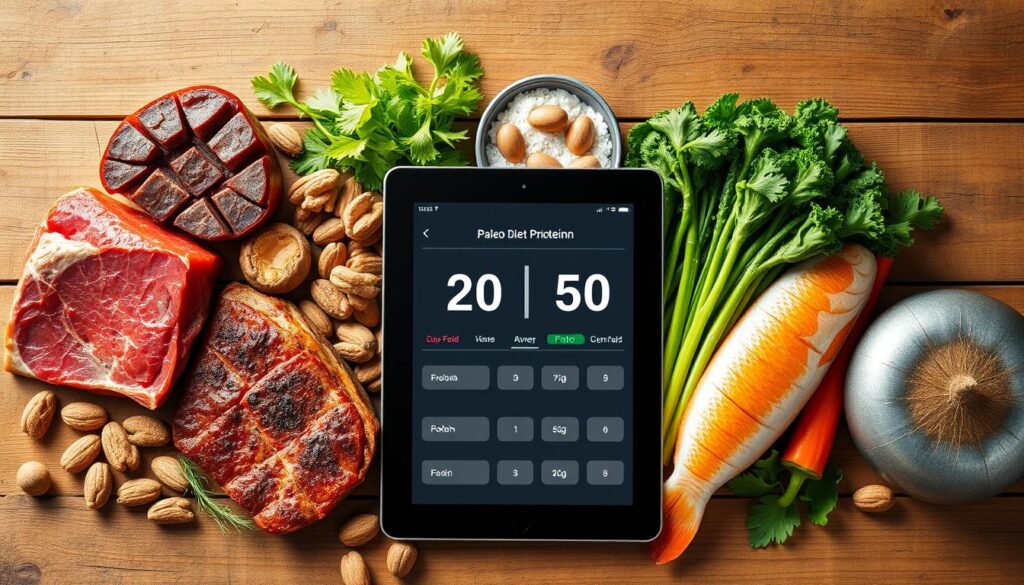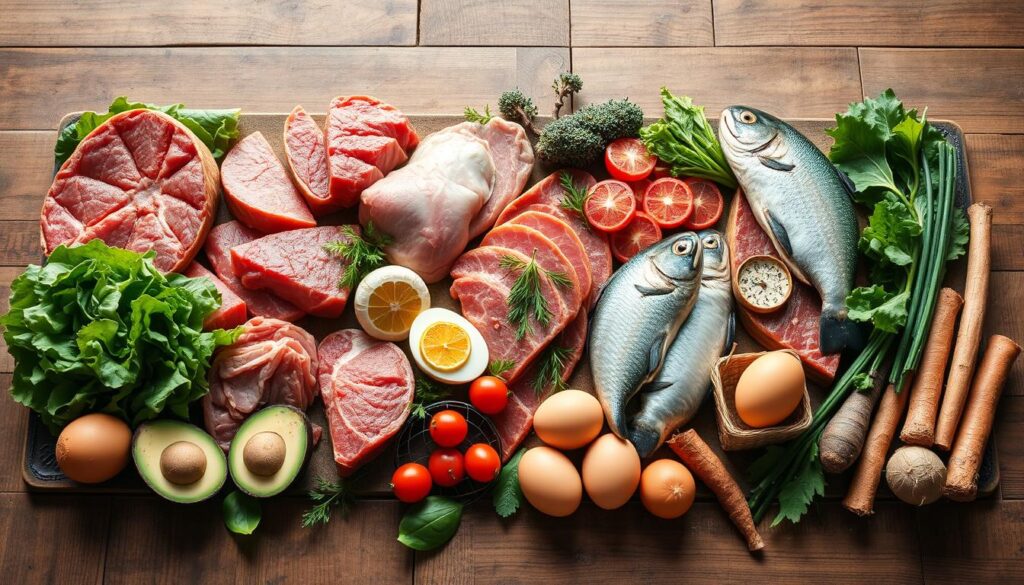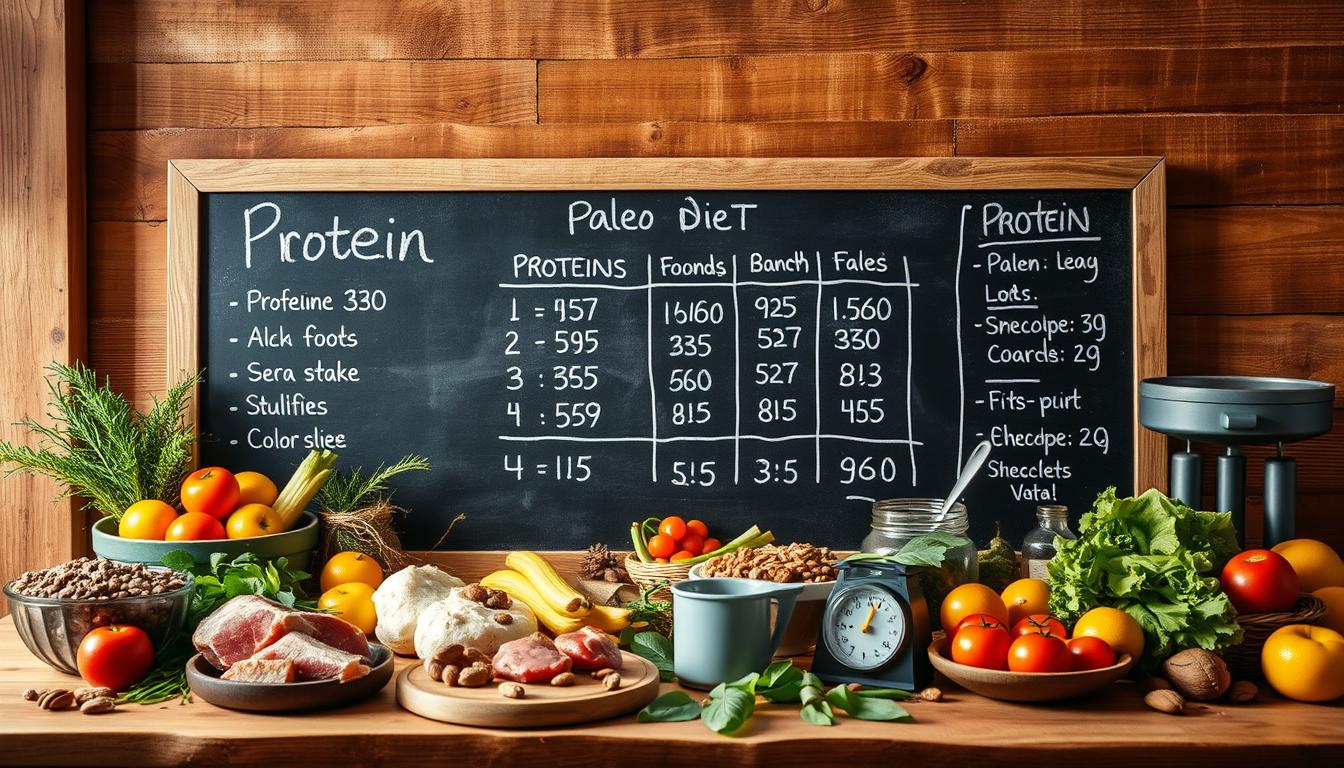Understanding your protein goal on a Paleo diet is key. It’s different from what most diets suggest. The Paleo diet aims for 30% of calories from protein.
This diet is based on eating whole, unprocessed foods. It’s like what our ancestors ate.
To figure out your protein goal, look at your body weight, how active you are, and your health goals. The Paleo diet focuses on good protein for muscles, health, and well-being.
Unlike other diets, Paleo often suggests more protein. Knowing this helps you eat better.
Key Takeaways
- Paleo diet typically allocates 30% of calories from protein
- Protein goal calculation depends on individual factors
- Focus on high-quality, unprocessed protein sources
- Macronutrient ratios differ from standard dietary guidelines
- Personal health objectives influence protein intake
Understanding the Fundamentals of Paleo Diet Macros
The Paleo diet is based on eating like our ancestors. It focuses on whole foods for better health and balance.
The Basic Principles of Paleo Nutrition
Paleo diet is about eating foods our ancestors ate. It’s all about:
- Eating grass-fed meats and wild fish
- Choosing organic fruits and veggies
- Using natural fats
- Staying away from processed foods, grains, and sugars
Standard Macronutrient Distribution on Paleo
The Paleo diet’s food balance is:
- 50% calories from fat
- 25% calories from protein
- 25% calories from carbs
“The Paleo diet is not just a diet, but a return to the nutritional foundations that shaped human evolution.” – Paleo Nutrition Experts
Why Protein Matters on Paleo Diet
Protein is key in the Paleo diet. It helps keep muscles strong and makes you feel full. Eating high-quality protein gives your body the amino acids it needs.
By eating about 30% of calories from protein, you help your muscles. This also keeps your hunger in check and your energy steady.
Protein Goal on Paleo Diet Calculator: Step-by-Step Guide
To figure out your daily protein needs on a Paleo diet, you need a plan. The protein calculator shows how much protein you should eat. It’s based on your body and how active you are.

- Body weight
- Activity level
- Specific health goals
- Muscle gain or weight loss objectives
A protein calculator for Paleo diets uses a simple formula: Body Weight (kg) x Protein Multiplier. If you’re not very active, the multiplier is 0.8-1.0 grams per kilogram of body weight.
| Activity Level | Protein Multiplier | Example Calculation |
|---|---|---|
| Sedentary | 0.8g/kg | 70 kg x 0.8 = 56g protein daily |
| Moderately Active | 1.0-1.2g/kg | 70 kg x 1.2 = 84g protein daily |
| Very Active | 1.4-1.6g/kg | 70 kg x 1.6 = 112g protein daily |
Using a protein tracking tool makes it easier to keep track of your protein. Remember, everyone’s needs are different. So, adjust your protein intake based on your goals and how your body reacts.
“Precision in protein calculation is key to optimizing your Paleo diet performance.” – Nutrition Experts
Pro tip for Paleo meal planning: Choose high-quality protein sources. These include grass-fed meats, wild-caught fish, and eggs. They help you meet your daily protein needs well.
Best Protein Sources Approved for Paleo Diet
The Paleo diet focuses on high-quality proteins. These proteins match our ancient eating habits. Choosing the right proteins boosts your health and nutrition.
Grass-Fed and Free-Range Animal Proteins
Grass-fed beef and free-range poultry are top choices for the Paleo diet. They have better nutrition than animals raised in other ways. Studies show they have more antioxidants and omega-3s.
- Grass-fed beef: Rich in essential nutrients
- Free-range chicken: Lean protein source
- Pasture-raised eggs: Complete protein package
Wild-Caught Fish Options
Wild-caught fish are great for omega-3s and are good for the planet. Salmon, mackerel, and sardines are the best for a Paleo diet.
| Fish Type | Protein (g) | Omega-3 Content |
|---|---|---|
| Wild Salmon | 22g | High |
| Mackerel | 19g | Very High |
| Sardines | 25g | Moderate |
Plant-Based Paleo Protein Sources
Animal proteins are key in the Paleo diet, but nuts and seeds are important too. Paleo-friendly vegetables also add protein.
- Almonds: 6g protein per ounce
- Pumpkin seeds: 5g protein per ounce
- Spinach: Nutrient-dense green protein
“Choose proteins that nourish your body and respect nature’s original design.”

Conclusion
Finding the right paleo protein balance can change how you eat. The Paleo diet goes back to our ancestors’ eating habits from 2.6 million years ago. It helps us understand health through whole foods. Studies show it can improve weight and blood sugar control
The Paleo diet has many benefits, but it’s important to see it as part of a balanced life. It can help reduce inflammation and improve how our body works. Eating high-quality proteins and foods rich in nutrients can make us feel full and happy.
Starting a sustainable diet needs careful thought about what you need. Talking to health experts can help avoid missing out on important nutrients. This way, your Paleo diet can help you reach your health goals.
The Paleo diet is still interesting to study. By eating whole foods and choosing proteins wisely, you can improve your health and life. Making smart food choices can lead to big changes.
FAQ
What is the primary difference between Paleo protein intake and traditional diet recommendations?
The Paleo diet wants you to eat more protein from whole foods. This is different from what most people eat today. It suggests eating grass-fed meats, wild fish, and other animal proteins that our ancestors ate.
How do I calculate my daily protein goal on the Paleo diet?
Paleo experts say eat 0.8-1.2 grams of protein for every pound of your body weight. This depends on how active you are, if you want to build muscle, and your health goals. Athletes or those wanting to build muscle should aim for the higher end.
Are plant-based proteins allowed on the Paleo diet?
Yes, but only some plant-based proteins are okay. You can eat almonds, walnuts, pumpkin seeds, and chia seeds. But, you should avoid legumes and grains.
What are the best protein sources for a Paleo diet?
Great Paleo protein sources are grass-fed beef, free-range chicken, and wild-caught salmon. Also, pasture-raised eggs, turkey, lamb, and wild game are good. These foods are full of nutrients and have little processing.
Can I build muscle on a Paleo diet?
Yes, you can! To build muscle on Paleo, eat enough protein, do strength training, and get enough calories from whole foods.
How does protein intake support weight loss on the Paleo diet?
Protein helps you feel full, keeps muscle while losing weight, and boosts metabolism. Paleo’s high-quality proteins can also reduce hunger and help with blood sugar control.
Are there any risks associated with high protein intake on the Paleo diet?
Too much protein can be hard on your kidneys, especially if you already have kidney problems. Always talk to a doctor and eat protein in balance.
How do wild-caught fish differ from farm-raised fish in the Paleo diet?
Wild-caught fish are better for you because they have more omega-3s and fewer bad stuff. They’re closer to what our ancestors ate.
Can vegetarians follow a modified Paleo diet?
Yes, vegetarians can try a Paleo diet by eating eggs, nuts, seeds, and some plant proteins. But, sticking to Paleo without animal proteins is hard.
How often should I consume protein on the Paleo diet?
Paleo experts say eat protein at every meal, 3-4 times a day. This keeps your energy up and helps your muscles all day.

